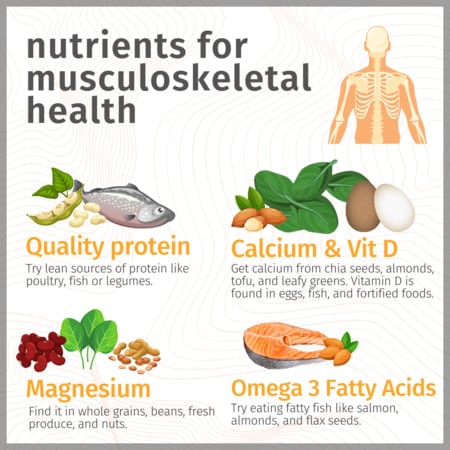Creak. Crackle. Pop. It’s often said that nothing makes a person appear older quite like poor mobility and a lot of groaning when they do things like stand up.
But are aches, and stiffness inevitable as we age? The answer is a resounding no – if you pay attention to your musculoskeletal health.

What Is Musculoskeletal Health?
The musculoskeletal system is a broad term encompassing the things that help us move: our bones, muscles, joints, and the ligaments holding it all together.
But with so many interconnected elements, a lot can go wrong.
Poor musculoskeletal health leads to poor mobility and, often, pain, which is one of the leading reasons people seek medical care. By some estimates, one in five people suffer from pain, and the resulting loss of productivity costs the economy about $300 billion annually 1
Studies also that patients with musculoskeletal pain are more likely to experience mood disruptions and trouble sleeping.3
Sarcopenia and musculoskeletal health
Incidents of musculoskeletal pain increase with age, with as many as 60% of older adults reporting pain.4 Sarcopenia is one contributor. Sarcopenia is the loss of muscle mass and strength that naturally occurs as we get older. It’s a common condition that can affect anyone, but it’s particularly prevalent in older adults.
Starting around the age of 30, we start to lose between 3 to 8% of our muscle mass every year.4 Sarcopenia can be a vicious cycle: the pain restricts our movement, which then accelerates our muscle loss. It’s therefore important to identify the root cause of any pain and address it, instead of masking it and not moving at all.
Tips To Support Your Musculoskeletal Health
1 – Regular exercise
“Move it or lose it” is a good aphorism for sarcopenia: underuse is one of the primary causes of muscle loss. 5
A well-rounded exercise program will address all aspects of the musculoskeletal system.
- Flexibility and mobility activities, such as yoga and stretching, help protect ligaments and tendons. Yoga also often helps support a positive mental outlook.
- Strength training is essential to help protect muscle mass. You’re never too old to start! One study found that adults between 83 and 94 years of age experienced muscle gains after starting a simple program with weights.6 Proper form will lead to the best results and protect against injury. If you’re not sure how to start, be sure to work with a certified trainer.
- Cardio. It also helps with weight maintenance, which can promote joint health. Thirty minutes a day of moderate intensity is a good baseline. It’s important to choose an activity you enjoy, and one that won’t exacerbate any existing injuries or weaknesses.
2 – Meet your body’s nutritional needs
A well-balanced diet supports muscle and bone health. Be sure to focus on:
- Quality protein. Protein is an essential building block for your muscles. A baseline of 1 to 1.3 grams of protein for every kilogram of body weight is a good starting point, but high levels of activity, and even aging, can increase your protein requirements.8 Focus on lean sources of protein like fish or legumes, and avoid processed meats as much as possible.
- Calcium and vitamin D. These work together for bone health. Chia seeds, almonds, tofu, and leafy greens are good sources of calcium. Vitamin D is found in eggs, fish, and fortified foods. The sun is a good source of vitamin D, but you may not be able to rely on it during the winter months. Many people find they have to supplement daily to get enough vitamin D, especially during the winter.8
- Magnesium. This mineral helps regulate muscle contractions and can help control muscle cramps.9 Good sources of magnesium include many whole grains, fresh produce, and nuts.
- Omega-3 fatty acids. Supporting a healthy inflammatory response in the muscles, joints, and ligaments is a key part of supporting musculoskeletal health, and studies show that omega-3 fatty acids may be helpful. Good sources include fatty fish like salmon, almonds, and flax seeds.10
Talk with a qualified wellness professional if you have questions about other supplements to support musculoskeletal health like turmeric11 and collagen12 which may help support a healthy inflammatory response and maintain muscle strength.
3 – Lifestyle factors to support musculoskeletal health.
Inflammation and muscular tension are also impacted by stress. When you’re stressed, your muscles tense up in their own “fight or flight” mode. Too much stress can lead to ongoing muscle tension and pain. Relaxation techniques for the mind and body include yoga, meditation, and stretching. Deep breathing can also help – when you experience pain, pay attention to changes in your breath and focus on full exhales and inhales. In addition to helping with stress, a solid night of sleep helps your muscles regenerate.
Pain management is another factor. The instinct is often to rest when you feel pain, but you’re often better off incorporating light movement, under medical supervision.13 If you stop moving, the resulting muscle loss and muscle tension can make things worse.
Chiropractic care and physiotherapy programs can help you incorporate healing exercises and identify the root cause of any pain.
You don’t have to put up with pain! A well-rounded lifestyle program to support your musculoskeletal health will help you move better and enjoy your best life.
Sources
1 Science Daily, “One in five American adults experiences chronic pain,” https://www.sciencedaily.com/releases/2021/04/210420092901.htm”
3. Garnæs, K.K., Mørkved, S., Tønne, T. et al. Mental health among patients with chronic musculoskeletal pain and its relation to number of pain sites and pain intensity, a cross-sectional study among primary health care patients. BMC Musculoskelet Disord 23, 1115 (2022). https://doi.org/10.1186/s12891-022-06051-9
4. Welsh TP, Yang AE, Makris UE. Musculoskeletal Pain in Older Adults: A Clinical Review. Med Clin North Am. 2020 Sep;104(5):855-872. doi: 10.1016/j.mcna.2020.05.002. Epub 2020 Jul 15. PMID: 32773050; PMCID: PMC8034863.
4/ Volpi E, Nazemi R, Fujita S. Muscle tissue changes with aging. Curr Opin Clin Nutr Metab Care. 2004 Jul;7(4):405-10. doi: 10.1097/01.mco.0000134362.76653.b2. PMID: 15192443; PMCID: PMC2804956.
5. Dodds RM, Roberts HC, Cooper C, Sayer AA. The Epidemiology of Sarcopenia. J Clin Densitom. 2015 Oct-Dec;18(4):461-6. doi: 10.1016/j.jocd.2015.04.012. Epub 2015 Jun 12. PMID: 26073423; PMCID: PMC4629409.
6. Bechshøft RL, Malmgaard-Clausen NM, Gliese B, Beyer N, Mackey AL, Andersen JL, Kjær M, Holm L. Improved skeletal muscle mass and strength after heavy strength training in very old individuals. Exp Gerontol. 2017 Jun;92:96-105. doi: 10.1016/j.exger.2017.03.014. Epub 2017 Mar 28. PMID: 28363433.
8. Kennel KA, Drake MT, Hurley DL. Vitamin D deficiency in adults: when to test and how to treat. Mayo Clin Proc. 2010 Aug;85(8):752-7; quiz 757-8. doi: 10.4065/mcp.2010.0138. PMID: 20675513; PMCID: PMC2912737.
9. Bilbey DL, Prabhakaran VM. Muscle cramps and magnesium deficiency: case reports. Can Fam Physician. 1996 Jul;42:1348-51. PMID: 8754704; PMCID: PMC2146789.
10. Kavyani Z, Musazadeh V, Fathi S, Hossein Faghfouri A, Dehghan P, Sarmadi B. Efficacy of the omega-3 fatty acids supplementation on inflammatory biomarkers: An umbrella meta-analysis. Int Immunopharmacol. 2022 Oct;111:109104. doi: 10.1016/j.intimp.2022.109104. Epub 2022 Jul 30. PMID: 35914448.
11. Johns Hopkins Medicine, “Turmeric Benefits,”https://www.hopkinsmedicine.org/health/wellness-and-prevention/turmeric-benefits
12. García-Coronado JM, Martínez-Olvera L, Elizondo-Omaña RE, Acosta-Olivo CA, Vilchez-Cavazos F, Simental-Mendía LE, Simental-Mendía M. Effect of collagen supplementation on osteoarthritis symptoms: a meta-analysis of randomized placebo-controlled trials. Int Orthop. 2019 Mar;43(3):531-538. doi: 10.1007/s00264-018-4211-5. Epub 2018 Oct 27. PMID: 30368550.
13. Tan, L., Cicuttini, F.M., Fairley, J. et al. Does aerobic exercise affect pain sensitisation in individuals with musculoskeletal pain? A systematic review. BMC Musculoskelet Disord 23, 113 (2022). https://doi.org/10.1186/s12891-022-05047-9

Recent Comments